by Michael Cropper | Jan 15, 2015 | Data and Analytics, Digital Marketing, Events, PPC, SEO, Social Media, Technical, Tracking |
Just before Xmas I was invited to speak at the Creative Entrepreneur event at Media City in Manchester to share insights into how online retail is changing. In-between speaking, it was great to listen to other online retail experts to hear their thoughts about where things are heading. So we can take a look through some of the discussions points in this blog post.

ASDA
First up we heard from Dom Burch, the serial speaker and senior director or marketing innovation and new revenue at Walmart UK (Asda). He shared his insights into how some of ASDA’s recent campaigns have been hugely successful in many aspects online and offline.
Dom’s first tip was around innovation and the importance of innovating throughout your entire business, regardless of how big or small you are. Innovation is key to long term and sustained growth. Simply dipping a toe in the water isn’t going to cut it here, Dom advised that you need to be giving projects at least 6 months to succeed (or fail!) so that you can be confident that you have exhausted all possibilities for the idea and had the time to gather data and assess the results accurately.
With all innovative ideas, you are starting with a goal of some kind for the business. Starting with ambitions to “become a big business” is equivalent to starting with the idea of “making a video go viral”. It’s simply the wrong approach to take and will inevitably lead to disappointment as goals are not hit. Instead, start with goals that are relevant for your business, goals that are in-line with your customer demands and goals that you can actually influence.
In between these ideas, Dom shared a few interesting statistics about ASDA;
- ASDA FM listeners have more people listening that Radio 1 and Radio 2 combined
- There are over 18 million customers who visit ASDA stores weekly
- ASDA’s website has over 300 million impressions every month
These are quite similar figures to what was announced last year at a digital marketing conference in Manchester.
With ASDA spending over £100 million per annum on broadcasting adverts, Dom’s approach was to get the PR team using Twitter, which was quite a challenge. Spending as little as 2 hours per week on Twitter, the newbie-to-Twitter PR team were already having a conversation with the editor of Vogue within 2 weeks. Where else could you get this kind of conversation going in 2 weeks? It simply wouldn’t be possible.
Another tip came in the form of doing something yourself first so that you know how to do it. This is something that I firmly believe in personally and in business. If you don’t at least understand what is happening, how can you ever hope to really manage this process? This is not to say you need to be an expert in every aspect as this would be impossible. Instead, it is hugely important to get a good grasp on every aspect within business and digital so that you can fully understand why things are being implemented and the reach they will ultimately have.
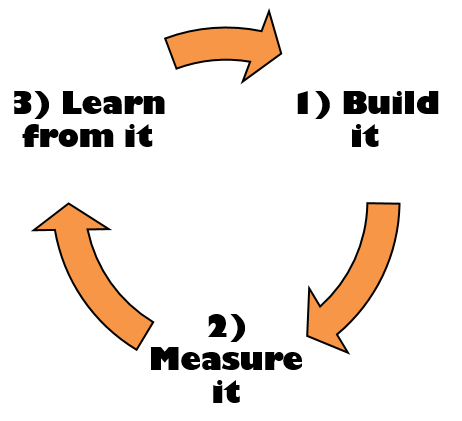
The simple process above will help you to build fast, fail quickly and innovate throughout your business at speeds you have never done before. Ideas are worthless, implementation is key and the only way to see what does and doesn’t work is to loop through the process as fast as possible, while giving every idea the time and energy to succeed.
Have a think for a moment, what are the 10 ideas that you have been talking about in your business last year? I can guarantee that there will certainly have been more than 10 ideas, but what were the 10 most important ideas? How many of these have you actually implemented, 5, 3, 1, none? Start the year off as you mean to go on. Run through these 10 ideas and measure everything to see how they impact your business. Capture the data and make informed decisions about the success of each campaign or idea.
For established businesses like ASDA, they aim to spend between 1-5% of their marketing budget on what Dom called “Trial and Error” campaigns which may or may not work. For businesses within the SME market, I would suggest this should be much higher as you are often still in the stages of experimenting with campaigns to see what works for your business. We naturally review and manage a lot of campaigns in the day to day work we do, although even we cannot tell you with 100% accuracy what will or won’t work for your individual business. We can certainly take into account the years of expertise and make a highly educated decision, although every business and every customer is different.
ASDA know that 74% of their customers are on Facebook, 20% are on Twitter and 15% of their customers watch YouTube daily. This information allows ASDA to invest their digital marketing spend in the right areas and not simply spend money on ‘more followers’ with no engagements. Their YouTube strategy focuses on how-to style videos and researching products which are broken down into 3 main groups;
- Hygiene content: Something that is core to what you do and for your core target market
- Hub content: Regularly created content designed to push this in front of your audience
- Hero content: Large scale campaigns to raise brand awareness, think about the epic Volvo Trucks campaign
The next of ASDA’s campaigns that was shared was with the involvement of Tanya Burr. Who you ask? Ask your teenage daughter if you have one. If you don’t, like me, then I also had to Google her to find out a bit more about her! She is described as a “Beauty, Fashion, Baking, Lifestyle Blogger & YouTuber” in a nutshell. And more than that, she has 1.2 million followers on Twitter. This is the reason ASDA worked with her, to reach this huge audience. The reach that ASDA’s products gained on social media was astronomical, just take a look through the number of views for each video that they produced together and you will start to understand how collaborations like this can pay off. Where else could you gain that kind of reach? To put things into context, Game of Thrones receives around 1.3 million views every week, which is less than what ASDA managed to reach with this collaboration. Likewise, Tanya Burr has more followers on Twitter than Sheryl Cole, Madonna and BBC Radio 1. Just because you have likely never heard of people like Tanya, doesn’t mean that they aren’t hugely successful.
When looking at YouTube videos specifically, always keep an eye out on the engagement levels and not simply the number of views of a video. Any brands that have a lot of views yet very few likes/dislikes means that they have likely paid a lot of money to drive traffic to the YouTube video and no-one liked it so they just bounced straight back out again. High engagement levels allow you to listen directly to your customers in ways like never before. ASDA’s videos with Tanya weren’t simply ‘buy this product’ videos, that’s boring and a fast way to drive customers away. Instead, they focused on food, health and wellness, beauty and style.
ASDA took this whole campaign one step further by creating the Mums Eye View YouTube channel which linked together their partnerships with Tanya Burr, Zoella and the Lean Machines. Google them all to grasp the scale of what is being achieved with strategic partnerships. This is a very young audience that ASDA was targeting here and one that has clearly paid off. With reports of as little as 2p per view of a YouTube video, 70% retention rate, 4 minutes minimum viewing time with an average of 7 minutes in length per video. You could only achieve these results with effective digital marketing that focuses directly on your customers. Not once did ASDA think “let’s make this video go viral”. What this also shows is that people like long form content on the web. No more do videos have to be 2 minutes in length, don’t be afraid of pushing the boundaries to meet customer demands.
This brings us nicely onto newspapers and traditional newspaper advertising. Quite frankly, no-one reads newspapers anymore, and I don’t say that lightly. Ask yourself, when was the last time you bought a newspaper? Personally, I can’t remember the last time I bought one, other than on the occasional times when I’m featured in one to keep as a little memento. Keep everything into context, could you seriously generate a response of someone looking at your advert for 4 minutes in a newspaper? I don’t need to answer that for you, it is clear. For ASDA, they know that 4/5 people don’t shop in ASDA and that is OK. So why spend £150,000 on a single press release in a national newspaper when 4/5 people of the people still reading newspapers aren’t ever going to be interested in ASDA anyway?
The summary of Dom’s keynote speech was that brands and businesses need to take a step back and see what is happening in the world. It’s time to start creating more content that relates to your audience.
Cyber Security
The next session was all about cyber security and the steps you can take to protect yourself. You need to look no further than the recent headlines about how many companies have been hacked into last year with millions of customer details stolen; eBay, Sony, Moonpig and endless more including 273 million customer details stolen from Yahoo and 250,000 customer details stolen from Twitter.
Some interesting statistics announced around cybercrime included that it costs the UK economy over £6.8 billion per year and the global economy £238 billion annually. With 81% of large businesses having experienced security breaches in 2014. The cost of a typical breach is now at £1.15 million, up from £600,000 in the previous year.
Some of the most common attacks are due to very basic hacking just after Update Tuesday. Windows PCs are updated every Tuesday with security patches that have been identified to keep your system and data safe and secure, yet so many people either ignore the messages on their computers or simply turn off the automatic updates. This is mad! As part of the weekly update from Microsoft, the hackers use this information as a shopping list of exploits on computers around the world they can attempt to get access to. If your system isn’t up to date, then you could be at risk.
Moving onto more sophisticated attacks such as DDoS attacks, which stands for Distributed Denial of Service attacks, these can bring down websites with ease. To the point at which you can actually purchase an attack on the black market to target a specific website for a specific amount of time. Unlawful and illegal hacking is turning into an underground commercial business. DDoS attacks are actually quite simple;

This method for DDoS are often using thousands, hundreds of thousands if not millions of computers from around the globe. For example, here you can see a short visualisation of a DDoS attack happening in real time on my personal blog a couple of years ago;
Have a read more about the full details if you are interested. The exact same thing happened to Mastercard, Visa and PayPal when they decided to stop sending funds through to the hacker group Anonymous. Whether you agree or disagree with this is another discussion all together and one that doesn’t have a simple answer. The important point here is that DDoS attacks are a real and present threat for businesses. While it is unlikely that you will encounter the wrath of some of the more prolific public hacking groups, the reality is that a lot of business websites for SMEs are hosted on cheap and nasty web servers that are poorly configured and have very little security built into them. Make sure your web server has the right protection in place to at least minimise the chances of DDoS attacks affecting you. The unfortunate reality is that if someone is determined enough to bring your website down, they will do. You can make it harder for this to happen though by having the right infrastructure in place for your website. Aren’t sure if your website and web server is protected? Then get in touch and we can review to check for vulnerabilities.
Moving away from hacking and looking at other types of data breaches now. Some of the most common data breaches often come in much simpler formats and often due to human error, aka. lack of awareness about threats. Threats including basic passwords on mobile and tablet devices to avoid automatic access to cloud based file storage systems for your company if a device is lot of stolen, to a deeper understanding of programming languages to avoid rookie mistakes.
Website vulnerabilities in particular happen for a number of reasons including unpatched software/content management systems/plugins, poor coding practices, poor server configuration, unencrypted data and more. Getting all of the above right is the absolute minimum businesses should be doing. Simply having a website built and not thinking about on-going updates is madness with how easy it is to exploit unloved websites. Every website should have regular and on-going maintenance to keep the website, content and data secure.
As of this year, there will be new EU Data Protection legislation that will be coming into force that businesses must adhere to. All of which is designed to move the current legislation into the digital age where customer data is collected at an alarming rate, often with very little visibility about what is being collected. This is likely to include full disclosure when data breaches happen so that customers are aware of what has happened. Far too often, businesses try and sweep large data breaches under the rug and hope that no-one will notice.
During the session, a live demonstration was given showing how easy it is for someone to steal your details – Even with my background, I was surprised at the level of things that can be done to steal personal details without you ever knowing what has happened. For example, simple things like clicking a link in an email can allow hackers to steal all of your saved login information in your browser. It really is that simple. Likewise, downloading a seemingly normal looking file from an untrusted source can result in a Key Logger being installed on your computer which will then be able to ‘read’ every single key you press, including your online bank account details and email passwords.
You may have heard about the infamous Stuxnet virus that swept the world almost by stealth last year. If you haven’t, you really need to read a few articles about this serious security threat; Wired, Business Insider, Wikipedia and what is even more worrying is that the source code for the virus is now publicly available on certain websites. As a quick overview if you haven’t come across Stuxnet before, the virus was designed specifically to find a physical controller located in power plants that controlled the heating/cooling of the nuclear material. As you can imagine, hacking into this and reporting an incorrect figure would lead to catastrophic results. This shows how sophisticated hacking has become. Some sources say that the virus was created by the US to target Iran’s nuclear facilities – how true this is, I don’t know. Other notable viruses including Duqu and Flame again highlight the level of sophistication that is happening right now.
Other common hacking attacks include the likes of SQL Injection attacks and Cross Site Scripting (XSS) attacks. Have a read up on these, again hugely important issues to be aware of and protect yourself against. Inexperienced and junior people working in digital are often oblivious to all of this type of information and most importantly how to protect against it. Always work with a company and people who are professional and have a very deep understanding of the industry they are working on. Remember the quote “If you think it’s expensive to hire a professional to do the job, wait until you hire an amateur”.
Now can you see why it is important to keep your systems, website and servers secure? Good, I’m glad the message has been received. If you don’t know what to do next, then get in touch and let’s have a chat.
Online Retail Panel
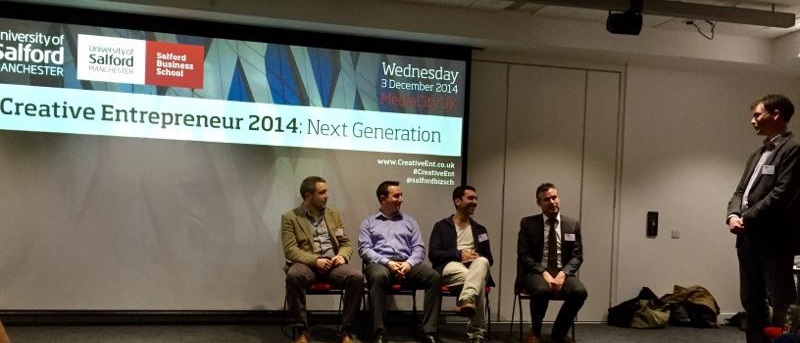
Next up was the panel that I was part of alongside three other digital agency owners in Manchester and London along with the Head of Online Retail for Iceland Foods, Andy Thompson. The session took a rather interesting turn to talk around a lot of digital topics about business growth through online retail, internal communication challenges and solutions along with some blindingly obvious opportunities for large brands to improve their sales online. The talks should be going online once they have been edited which you can look forward to watching, so for the meantime, here is a quick summary of the whole event and more information can also be found on the website;
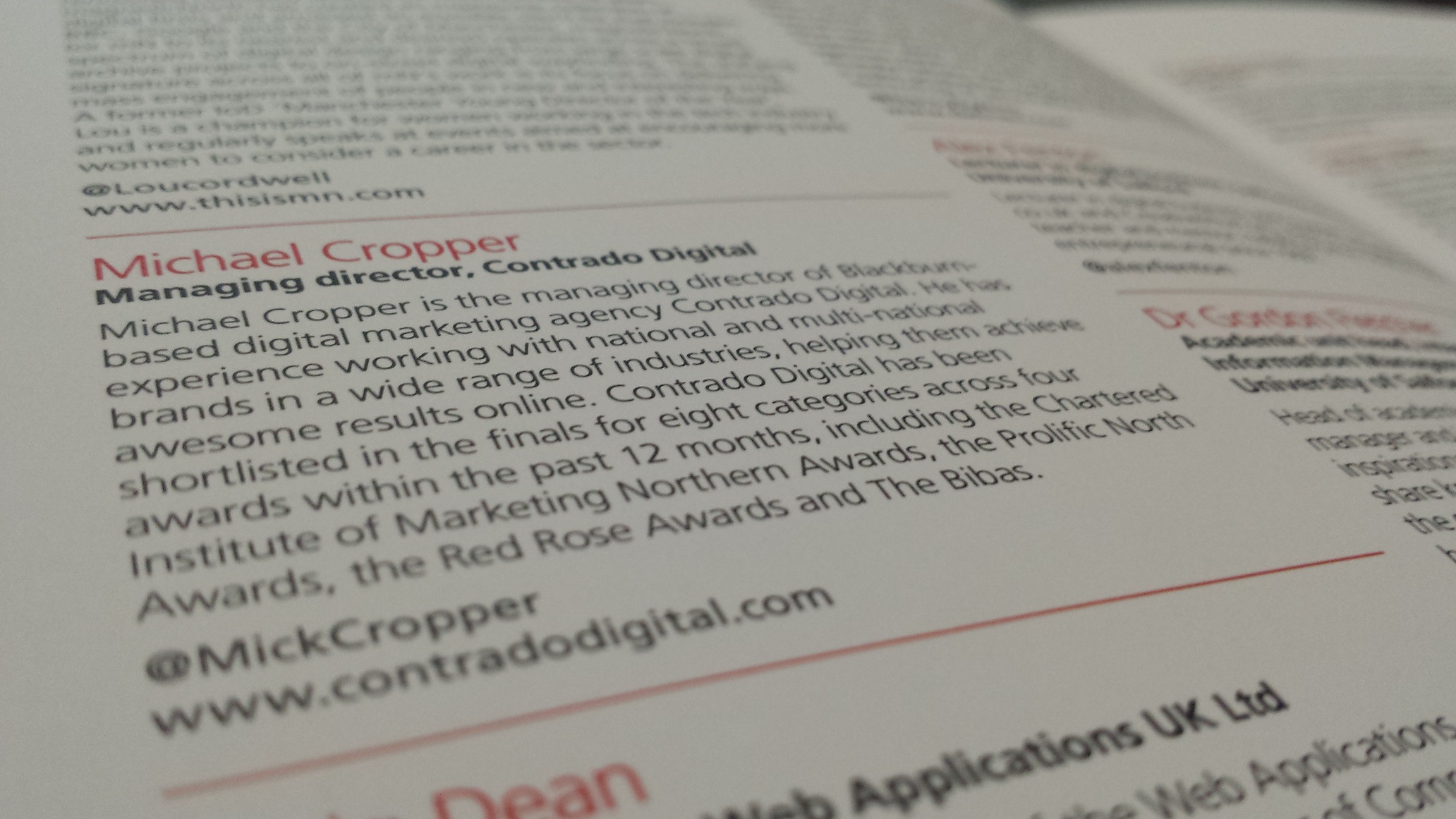
Digital Marketing, SEO and the Internet of Things
The last few sessions of the day are combined within this section. We heard from many different speakers and panellists in the final sessions with lots of great tips for businesses. One key message that is extremely relevant for the SME market is that you simply can’t have social media accounts without creative content. You need to be creating your own content and sharing this socially along with utilising other great content around the web to fuel your social media channels.
The Tales of Things by Oxfam
Oxfam was involved in a very interesting project with the University of Salford titled The Tales of Things. Oxfam have invested £1.4 million over the past 3 years with the aim of revolutionising business systems and processes through the use of digital technologies. The Tales of Things project was a very interesting one and one which I believe we will start to see more of over the next few years.
The idea was around selling donated products that also have a QR code attached to them. Customers looking at the item would then scan the QR code to listen to a short story from the person who donated the item. Oxfam found that this actually increased sales by 57% in the Manchester shop. They then extended this into Selfridges in London where celebrities donated items with the same concept behind. Within 14 weeks, they had this technology applied in 10 Manchester shops. This is ultimately a historical archive for objects that are traded, thus turning an object into something more than an object as it has a story behind it.
Personally I hate QR codes with a passion due to the way that they are misused in 99% of circumstances by businesses. Although in this instance with Oxfam, this is a really great way to bring things to live and genuinely adds value to the product being purchased and the customer experience.
This project has been on-going for a few years now so have a good read about the finer details over at the BBC, Oxfam and Tales of Things.
Cool Tech
Where would we be without a blog post talking about some cool technology that is on the horizon? Here is a really cool digital air hockey game that Tom Cheesewright and I played (which I think I won, Tom may disagree, not that I’m competitive in any way! );

Image courtesy of Aleksej Heinze
And this was even more amazing, a 3D holographic projection (apologies for the poor quality, it was taken on my smartphone);
Summary of Event
Overall, the event was excellent with lots of great tips and advice to take away and implement. I’m sure there are a lot of questions about what you need to be focusing on in your business after the security discussions and digital marketing opportunities discussed above. Get in touch and we can talk things through with you to see how we can support the growth of your business.
Keep an eye out for next year’s event
by Michael Cropper | Jan 14, 2015 | Digital Marketing, Future |
Digital is changing faster than ever, yet so many businesses fail to keep ahead of the essential changes required to meet customer demands. 2015 is the year where businesses who take digital seriously are going to thrive and leave their competitors well behind. It’s time to embrace digital and integrate digital technologies throughout your entire business, process and people. Here we are going to look at the priorities for your businesses to utilise digital to grow throughout 2015.
Platform
One of the common challenges for businesses is selecting the right platform for their website. A platform that allows members of the team to easily create, edit and delete pages, images and content throughout the website. A platform that puts you, your staff and your business in control of the direction of your own website. A platform that is capable of scaling as your business grows.

Image source: https://www.flickr.com/photos/ajpscs/
To keep things simple, you really need to be working towards one of the two leading platforms either WordPress or Magento. For most businesses within the SME bracket, one of these two platforms is really the only thing you need to scale your business. There are an awful lot of website platforms available to develop your website on, many of which have a lot of problems with them and are simply not good enough.
This is quite a big topic and is a little outside of the scope of this blog post, so we will cover this a little later down the line in a future blog post. For now, if you have any questions regarding the suitability of the platform you are using, then get in touch and we will be happy to give an honest opinion of the technology you are using and it’s suitability to cope with the growth plans for your business.
The important point around the platform and technology in use on your website is that it needs to be suitable for your business and puts the power in your hands with a Content Management System (CMS). Which brings us nicely onto the next point about ownership.
Ownership
As a business, you need to own your digital assets including your hosting solution and website. What this means is that you need to have access to your own assets and be able to change things as you require. Far too often businesses come to us and tell us the same story (we listen politely every time we hear the story! J), about how another website developer/company owns their website, their hosting and domain name, wants to charge a considerable amount of money for making basic changes on the website, which you should be able to do yourself, the relationship has broken down and they are refusing to release control of your own website to you.

Image source: Paul Townsend
Please, stop and think before purchasing a new website. You need to own everything that is going into it. A web development company exists to assist your business to grow, not to own a significant part of your digital assets and hold you to ransom for them.
Ownership comes in many forms from copyrighted images including stock photographs, your web hosting solution, your domain name, your emails, your website technology, your website content, your login details for all of the above along with external services that are being used on your website, social media channels and tracking solutions and many more. For everything that is implemented for your business digitally, you need to own everything to keep your business safe and secure.
Tracking
Would you like to give me £100,000? No? Why? How about if you gave me £100,000 and I gave you £120,000 back? How about now? Yes? What’s the difference? The difference is tracking. Tracking your digital investments and the return you are generating from your digital marketing channels. That’s the difference.

Image source: BK Koh
Most businesses simply aren’t tracking their digital marketing activities accurately which ultimately leads to bad investments and distrust in digital marketing activities. Businesses will quite happily spend hundreds of pounds on a printed advertisement in newspapers and magazines, thousands of pounds sponsoring a single event and even over £100,000 per year on radio advertising without any ability to accurately track direct results from those campaigns (yes, these are real figures and stories we have discussed with businesses!). Why? Because they are easy. It is easy to spend money on ‘Advertising’ without understanding what this is generating in return. What would happen if you didn’t do those things? What would happen if you reduced your spend in these areas by half? What would happen if you doubled your spend in these areas? Tracking is key to understanding profitability with marketing campaigns.
Traditional advertising, generally speaking, has an extremely low response rate and an even lower success rate. Compare this with digital advertising where you can track exactly what your results are;
Traditional Marketing
Investment –> Hard to track from here
Digital Marketing
Investment –> # of Website Visitors –> # of Conversions –> Revenue –> Profit –> ROI
Which brings us back to the question of how much money would you give me if you received more money back in return? It all comes down to tracking and data analysis. Being able to track results accurately from SEO, PPC and email marketing allows you to make smarter data driven business decisions. Invest in marketing activities wisely and most important track results accurately across all channels. Google Analytics is capable of tracking your every need.
Integrated Marketing
Have a think about the last time you purchased something in your own life, a car, a holiday, a TV, a laptop, a tablet, whatever. Did you ever just complete one single action during the purchasing journey you took? The answer is no. People are complex, people go through complex purchasing paths depending on their specific needs, level of trust, previous purchases and experiences. It is therefore no surprise that your customers also take a rather complex path when purchasing products and services from you. That’s why it is important to integrate your marketing channels to optimise every channel and touch point that your customers experience on their path to purchase.

Image source: Jon Tollefson
Think about your offline presence, digital presence including SEO, PPC, email, referral, direct, social and specific campaigns. When a customer experiences your brand on one of the marketing channels above, how do they feel? Are your marketing and communication messages the same across all channels? Are you even using all of the available marketing channels for your business? A positive or negative experience across a single touch point can result in a lost sale for your business.
The key message is to make sure you are active on all digital marketing channels available to you and ensure your customers have a positive experience. Join the dots across all digital marketing channels to enhance your customer’s lives through content, fun and interaction. This leads nicely onto the overall user experience of your brand online.
User Experience
When your customers interact with your brand online what is the experience they have on your website, from mobile devices, on social media, when they search for you on Google, when they see a PPC advert, when you send an email newsletter? Every experience is either a positive or negative one, there is no middle ground.
Taking your website first, how easy is your website to use in general and more specifically on mobile and tablet devices? Responsive design has been talked about for a couple of years now, yet still many websites simply aren’t user friendly and are difficult to use from a mobile. You need not look any further than the endless statistics that are being continually released about the proliferation of mobile devices throughout our everyday lives and interactions with brands online. If your website does not work effectively on a mobile device then you may as well deny people accessing your website from mobile devices as this sends the same message. Any new website that is developed in 2015 needs to be responsive as a minimum, just as it did in 2014. It needs work effectively on mobile devices and tablets.
What is the experience when people receive your weekly or monthly email marketing newsletters? Is this a typical sales focused shouting emails asking your customers to buy with yet another special offer, coupon code or last minute flash sale? Boring. Yes these type of emails clearly do work and should be part of an effective email marketing strategy, but they should not be the main focus. Aim to educate your customers, entertain them and show the personality of your brand. Look to engage with your customers and grow your email list.
What is the experience when people interact with your brand on social media? Are you busy talking about nonsense, retweeting everyone else’s tweets with no idea why and spending hours a day being busy without understanding what you are getting back? Stop, just stop. It’s time to start taking social media seriously, what are you looking to gain from social media? How is social media integrating with your overall digital marketing strategy? Who are you looking to engage on social media? Turn your social media activities into a positive experience for your customers online. Social PPC is essential to reach your customers on social media channels in 2015. Businesses have been testing this over the past couple of years to grow their audience and can be a very successful way to increase the reach of your messages.
Data Security
In 2014 more data security breaches were announced than ever before. The graphic below highlights how intense the large scale data security breaches have been in recent years;
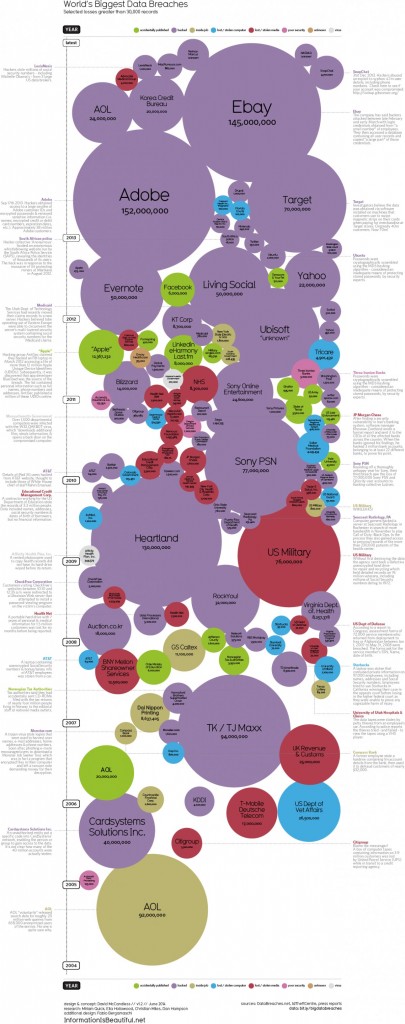
Click image above for larger image
Source: http://uk.businessinsider.com/data-breaches-infographic-2014-12
Many businesses aren’t taking data security seriously, especially within the SME group of businesses. People running websites based on popular content management systems often take the approach of ‘build it once and leave it’. This isn’t good enough. Instead you should be continually updating your website, updating plugins and patching security holes. All of which can reduce the possibility of your website being hacked.
Many times in the last year I have personally received an email from a senior person within a professional large business which has been sent after they have been hacked into, i.e. it wasn’t them who actually sent the email as it contained a virus. While this is never 100% inevitable, there are many things that you can do as a business to protect yourself online. Often with old email technologies, if someone hacked into your web server, they may also find it easier to access your email system.
The government recently announced the Cyber Essentials scheme to help businesses take data and security seriously within their business. Have a good read over what this means for you and your business. In addition to this, Google recently announced that they are considering marking all non-HTTPS websites as ‘non-secure’ which really highlights where websites are heading in the future. Security is key with your business, you digital assets including your website and your customers’ data. Keep things safe and secure by taking the steps needed.
A Bit Further Down the Line
Where would a 2015 blog post be without looking at some of the other items on the horizon but aren’t quite going to become mainstream in the next year. There is a lot of technology in the fringe that is growing in popularity which is really exciting for end users and certain businesses, although it is not quite at the stage for most businesses to take seriously. But let’s take a look at it anyway!
Wearable technologies have been talked about a lot recently and I recently had the opportunity to test out Google Glass and the Oculus Rift, both of which were rather cool I have to say. Recently Sony announced a similar technology designed to remove the ‘cringe factor’ of Google Glass.
Recently Nest announced that Google Now was now integrated into the device, bringing a HAL 9000 experience to the home. Such fun. This was an inevitable next step for Nest which is clearly one of the significant reasons why Google paid such a hefty sum for Nest in the first place. As Nest increases in popularity, Google is going to become further engrained in our daily lives without us having to visit a specific device to search, instead we can just say “Ok Google, what was the football score this afternoon”.
Uber, the taxi booking app, has taken the world by storm. Expect to see a lot more digital disruption in all industries in 2015 and beyond. For your business to stay ahead this year it is vital to innovate throughout every aspect of your business, products and services. Digital disruption is coming to every industry – be prepared.
Facebook search engine? Maybe. Well Facebook did recently announce that they are no longer going to be using Bing for their search provider. Does this mean that they are going to start competing with Google in the search space? Who knows? It will be interesting to see how this develops this year.
Internet of Things is a recent hot topic in digital which is still very much in its infancy. In the very near future, every electronic device will be connected to the internet, from sensors to devices and everything in between. When this happens, it is going to be a very exciting time as the online and offline worlds are connected more than ever. The data and insights that can be gained through such huge data could optimise the physical world we live in to make services and systems more efficient.

Image source: John Biehler
Bridging the gap between the online and offline worlds is going to become seamless for customers. Customers don’t particularly care whether they are dealing with your business online or offline, they simply want to deal with your business. Services such as our WiFi Marketing & Analytics system is ideal for leisure based venues to connect the online and offline dots together. Capturing customer data is the most valuable currency online in 2015.
Summary
Digital is going to be moving at a faster rate than ever in 2015. Your business needs to be prepared and take advantage of these changes or risk getting left behind. Only the strong will survive. Would you like to discuss how we can support your business goals throughout 2015? Then get in touch for an informal conversation about how we can help or take a look through the many services we can provide to increase revenue for your business.
by Michael Cropper | Jul 28, 2014 | Data and Analytics, Digital Marketing, News, Technical, Tracking |

That’s right, we’re now a Purple WiFi Authorised Reseller! You may be wondering just exactly what Purple WiFi is and why we have chosen to work with Purple WiFi. Before we go into that, let’s just look into the near future to see where the world is heading.
At some point in the near future, all business will start with some form of digital interaction. Whether this is business to business or business to consumer, or what is starting to be referred to as person to person. With smart technologies creeping into our daily lives from Google Glass, the Oculus Rift and a 3D printed mini me, we are seeing traditional online and offline areas blending into one. No longer is ‘digital’ a marketing channel that is completely separate to core business. For many businesses, ‘digital’ is becoming core business as brands start to interact with customers at every step along the way, from visiting physical stores to purchasing products on the website to connecting with customers on social media. Everything is digital.
For this reason, we predict that in the very near future, brands are simply going to have to join the dots for customers between all touch points, regardless of whether this is online or in the real world. That is why we have become a Purple WiFi Authorised Reseller, because the software is capable of joining these dots together which we believe are becoming increasingly important. Joining the online and offline worlds together in a way that has traditionally been extremely difficult for brands to do is now possible.
What is Purple WiFi?
Purple WiFi is extremely advanced and cutting edge technology that is designed to turn the current free WiFi in your premises into a marketing tool to directly increase revenue. To keep this really simple, Purple WiFi is a piece of software that is installed on your router (the ‘thing’ that connects your customers to the internet).

It is this software that gives your free WiFi the boost that is needed to which customers are in your premises, how many times they have visited before and how long they have stayed. In addition, you can see full customer demographic data including name, age, gender, email address and hometown. All of this amazing data allows you to understand who your customers are better than ever and communicate with them to increase the frequency of their visits. Get in touch with us to see a full list of the amazing demographic data you can capture with the tool or to request a demo.
Essentially, if a customer visits your venue once per month and we can turn this into them visiting once every two weeks through targeted email marketing, then this has doubled your revenue per head for that specific customer. It isn’t always about getting ‘new’ customers through the door, if you can achieve the same revenue growth from your current customers then this is also a good opportunity.
Why we have chosen to work with Purple WiFi?
Quite simply, Purple WiFi are the leading players in the market providing this software who are working extensively with global hardware manufacturers including Cisco, Linksys, NetGear, TP-Link, Cisco Meraki, Deliberant, HP, Mikrotik, Open-Mesh, Ruckus, Xirrus, Airtight Networks, Buffalo, Trendnet and Ubiquiti.
The Purple WiFi software works on the leading hardware solutions for your wireless network, meaning that you can be confident that you can start to benefit from this software sooner rather than later.
Turning Purple WiFi into our WiFi Marketing and Analytics Service
Purple WiFi on its own is great, but as with anything, if you don’t use the tool to its full advantage then you won’t get the most out of it. After speaking with a lot of businesses ranging from bars and restaurants to bowling alleys and shopping centres, one of the common themes coming from discussions is around the time it will take to manage the platform.
This is why we have created a service around Purple WiFi which we call ‘WiFi Marketing and Analytics’. It is this service that is designed for us to do look after the marketing part so you can focus on doing your job within the business. Instead of having to learn how to use another tool to maximise its potential, we will do that for you and use our expertise and knowledge of running multiple campaigns to get the best results for your business.
Whether you are simply looking to offer your own branded free WiFi solution for your customers, or whether you are looking to utilise this for a data capture tool, or even if you are looking for the full works to utilise all of the above and turn your free WiFi into a marketing tool to increase revenue. Whatever you are looking for, our WiFi Marketing and Analytics service can be tailored to your specific needs and we can talk you through how this works in practice within your own organisation.
Find out more about our WiFi Marketing and Analytics service over on our services page which talks you through how this works in more detail along with giving some ideal examples of how this new technology can be used to the full advantage. Purple WiFi only sell the software through authorised distributors like ourselves, so get in touch to find out how this can work for your business.
We don’t simply build websites. We work with your business to increase revenue through digital technologies, which just happens to include things like web design, search engine optimisation, pay per click advertising and now WiFi Marketing & Analytics. Get in touch if you would like to know more about how we can support the growth of your business through digital marketing and new technologies.
by Michael Cropper | Jun 9, 2014 | Data and Analytics, Digital Marketing, Tracking |
Spending your marketing budget is easy. Spending it on items that are delivering a return is a fine art. With tools as powerful as Google Analytics at our fingertips, surely every business is measuring the results from their marketing activities? Well, in our experience, even large and well established companies find it difficult to track marketing activities accurately.
What this means is that marketing budgets are often not spent as effectively as they could be. This would be fine if all businesses had an unlimited marketing budget, but this isn’t the case. Marketing budgets are always limited, which means that businesses need to be investing in marketing channels that are performing well for their business.
Throughout this blog post we will talk through the different ways you can track your marketing activities effectively which will mean you can make smarter data driven business decisions. Tracking marketing activities accurately means you can invest further in activities that are working well for your business and stop spending money on activities that aren’t generating a return.
All of the items we are going to talk about within this blog post are possible to track with ease through Google Analytics.
Set up Goals
What is the main goal you want website visitors to do? It is to purchase a product, enquire about the services or solutions you provide, or do you want them to download a guide from your website? Within Google Analytics you can set up a maximum of 20 goals within Google Analytics, which means that you can track an awful lot of data;

Set up Goals within Google Analytics
To track your marketing activities accurately this is absolutely essential to set up useful goals for your website. This can vary hugely between different websites based on what you are trying to achieve. Although have a think about both macro and micro goals on your website. What are the key things you want your website visitors to do?
- Contact us
- Request a call back
- Follow you on social media channels
- Purchase a product
- Download a resource or guide
- Find a local branch or store
- Click and collect
Once you fully understand what you would like your website visitors to do, then you can start to track your marketing activities accurately. Quite simply, if you are paying for website visitors that aren’t working towards your key goals then maybe it is worth spending the marketing budget in areas that are working towards those goals instead.
Within Google Analytics, setting up goals couldn’t be easier with the many templates that are already available for you to customise for your individual website;
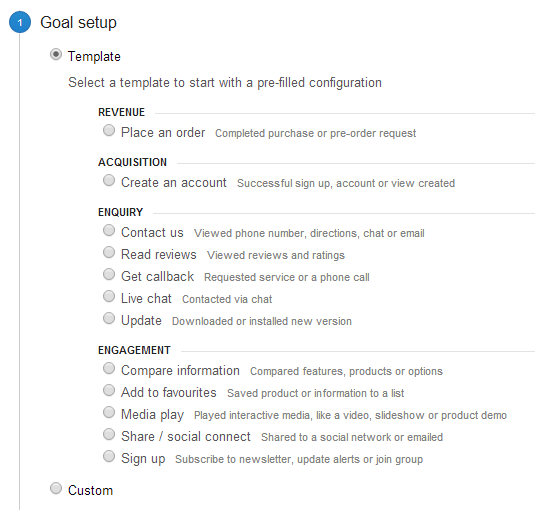
Goal Templates within Google Analytics
Use Goal Funnels
When you are setting up your goals above then you will be asked if you would like to use Goal Funnels. These are the specific steps that customers must go through before completing a goal. For example, if you are selling products online, then you will have multiple steps in the checkout process.
It is essential to set up the correct tracking for your purchasing funnel so you can understand how customers are behaving when they are completing this process. Below you can see an example for how this can be set up;
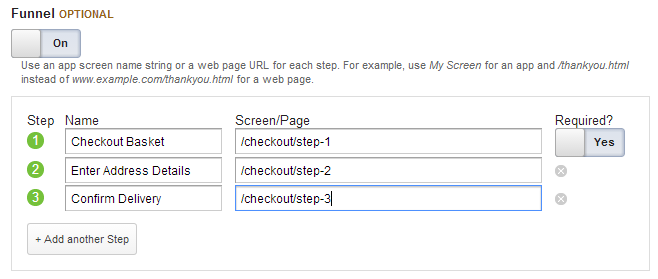
Goal Funnel Options within Google Analytics
Once you have configured this correctly you can easily visualise this information within Google Analytics. This will show you exactly how your website visitors are behaving and most importantly, where they are dropping out of the purchasing funnel. This is invaluable data that can provide insights into where improvements can be made to increase the number of people who complete their purchases.
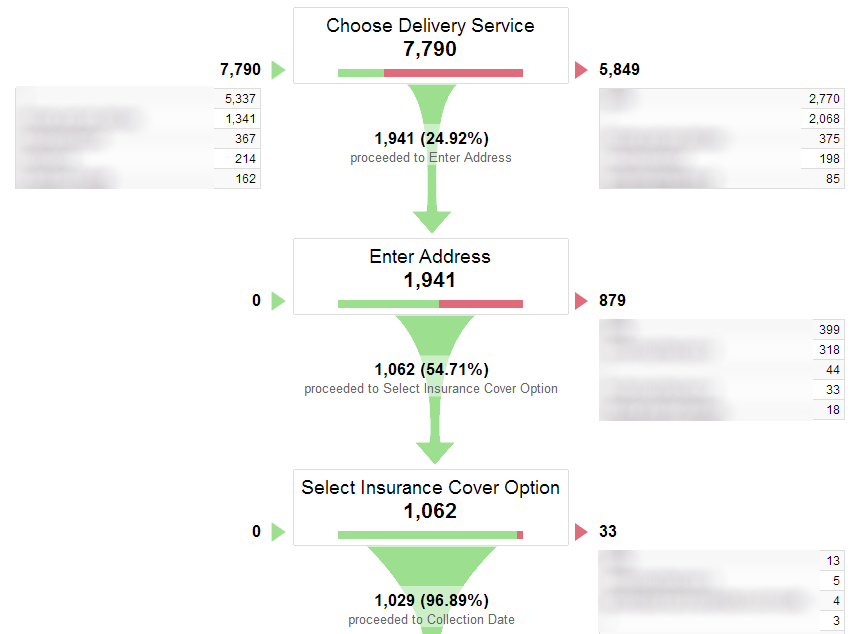
Funnel Visualisation in Google Analytics
This data shows you the number of people who move on to the next step in the purchasing funnel and it will also show you the number of people who leave the purchasing funnel. More importantly, it will tell you where they went. Did they go to another page on the website for further information, or did they leave the website completely? This information can really help to understand your customer behaviours and look for ways of improving the user experience.
Ecommerce Tracking
If you are selling any products or services through your website, then setting up ecommerce tracking within Google Analytics is absolutely essential. The data that this provides means that you can easily see which products and services are the most popular, and most importantly, which traffic sources are leading to customers purchasing.
Understanding which traffic sources are working best for your business means that you can then readjust your marketing budgets towards the most profitable areas. Only through correct tracking is this possible. Below you can see some of the useful data that you will start to receive once you implement ecommerce tracking on your website and in Google Analytics;

Ecommerce Tracking within Google Analytics
Just as with goal tracking, the important point here is that once you fully understand which traffic sources and marketing activities are working towards increasing sales through your website, then you can start doing more of this. All of which is essential to fully understand how your marketing activities are performing.
Implementing ecommerce tracking is a little more involved than setting up goal tracking. Firstly you have to enable ecommerce tracking within Google Analytics then also implement additional tracking codes on your checkout completion page;
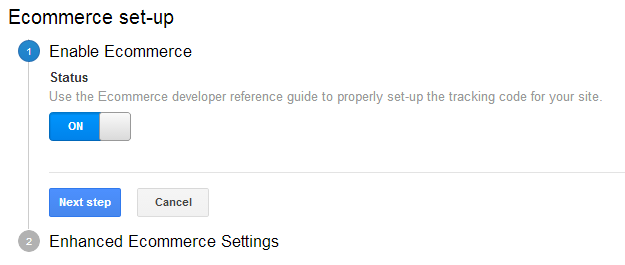
Ecommerce Setup within Google Analytics
To learn more about how ecommerce tracking can be set up, it is recommended that your website developer reads through the following guidelines from Google. To summarise the requirements, there needs to be additional information on the checkout complete page that contains all of the following information so that Google Analytics can pick this up and fire the data into the reporting platform;
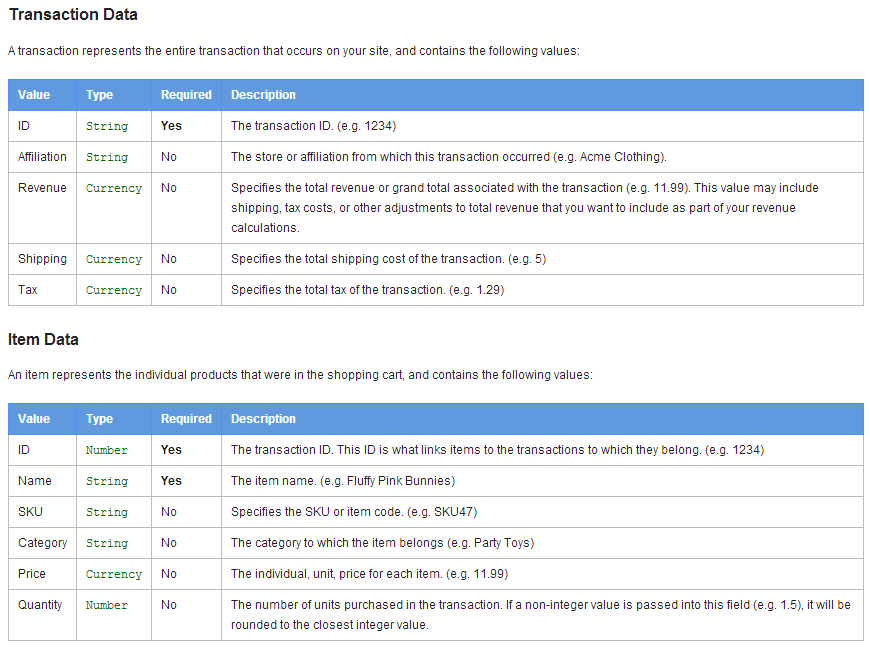
Ecommerce Settings for Checkout Complete Page for Google Analytics
Call Tracking
One area that most businesses don’t realise is available is advanced call tracking tools which are designed to bridge the gap between your website analytics data and customers who call your office number. The reason why this is so important for a lot of businesses is because website visitors will often call the number on the website instead of completing a contact form.
What this means is that if you don’t have a call tracking solution in place, then you will be under reporting on the results. For example, if you ran a large pay per click advertising campaign and you started to receive a lot more phone enquiries, then this would be a challenge to monitor using only traditional website analytics. If this was the case, you would go back to monitor the performance of your recent campaign within Google Analytics and see that you received a lot of traffic to your website but very few people enquired using the contact form. You would likely mark this campaign as a poorly performing one and one that would guide your future investments in marketing activities down a different path. Where in fact, what has actually happened is that the campaign was a roaring success and generated a large amount of revenue, although it was all completed over the phone opposed to through the website.
Advanced call tracking solutions like this aren’t right for every business. Although if your business does do a lot of sales over the phone, then this really is something that you should be looking at. Purely to track all of your marketing activities accurately so you can calculate a true return on your marketing spend.
Assisted Conversions
Traditionally most businesses look at the results achieved from a marketing campaign on the basis of a ‘Last Click Attribution Model’, which simply means that the last traffic source that the website visitor used to arrive at your website is attributed to the success of that goal completion. For example, if a user visited your website first from organic search, then revisited a few days later through a link they found on another website, then revisited a few days after that via a pay per click advert on Google and made a purchase, this would mean that the pay per click advert is deemed to have been the traffic source that drove the sale.
Although what if this isn’t quite a true picture? What if the other two touch points were critical points within the purchasing journey and if they didn’t see these items, then they would have been less likely to purchase when they clicked on a pay per click advert?
Understanding the full customer purchasing journey is possible through the use of Assisted Conversions within Google Analytics. This powerful tool means that you can get a full and true picture of how your customers behave prior to purchasing your products and services.
For example, if you saw that people who read one of your travel guides or blog posts, then also read a review on a review website, were then more likely to purchase when they saw a pay per click advert, then you would be much more willing to invest in those other areas as you can attribute a value to these customers.
Let’s say those customers converted 20% higher than those who just arrived on a pay per click advert. This allows you to fully understand the key touch points that are contributing towards the customer enquiry or purchase. Knowing this means that
For example, take a look at the following information;

Assisted Conversion Summary Data within Google Analytics
It is clear to see that the Assisted Conversion Value is actually a significant amount, meaning that if you weren’t active in other areas then you would likely not have received this revenue or amount of enquiries. Most importantly you can then break this down into the various traffic sources so you can understand how they are contributing towards sales through your website.

Assisted Conversion Data within Google Analytics
Summary
Overall, there are a variety of ways you can use the features within Google Analytics to calculate a true return on your marketing spend. If you aren’t tracking your marketing activities, then quite simply you are spending aimlessly and are likely to be spending money without generating a return.
The key message to take away is that it is essential to be tracking all of your marketing activities to be able to make smarter data driven business decisions. Focus on marketing activities that are generating a return for your business and drop the areas that aren’t contributing.
Once you fully understand how your marketing activities are contributing towards increased enquiries and increased sales for your business this will transform the way you invest in marketing activities. All of this data allows you to calculate a true return on all of your marketing activities.
by Michael Cropper | Jan 28, 2014 | Digital Marketing, News |
We are really pleased to announce that we are now an official HootSuite Solution Partner!


We believe social media is an integral part of any digital marketing strategy which is why we have become a HootSuite Solution Partner. This enables us to offer a best in class service for our clients with social media strategy and management to help your business grow online.
HootSuite is a social media management system for businesses and organizations to collaboratively execute campaigns across multiple social networks from one secure, web-based dashboard. Key social network integrations include Facebook, Twitter, LinkedIn, and Google+, plus a suite of social content apps for YouTube, Flickr, Instagram, Yammer, Tumblr and more.
In 2013 HootSuite surpassed 8 million users, including 750 of the Fortune 1000 companies. HootSuite is quite simply an extremely powerful tool that allows you to manage your social media channels effectively, leaving you more time to spend on creating some awesome content for your business.
Sign up for a 30-day free trial of HootSuite Pro now and see how valuable this tool can be within your business.
In addition to Contrado Digital becoming an official HootSuite Solution Partner, I have also passed all exams and become a Certified HootSuite Professional, so we are well placed to help with all your social media strategy needs. Get in touch if you would like to find out more about how we can help your business utilise HootSuite and the many social media platforms available.

Michael Cropper, HootSuite Certified Professional
We are now officially launching our social media strategy service to help grow business take advantage of one of the fastest growing channels in digital marketing. Finally, to celebrate we are already tucking into the delicious cake you can see below;
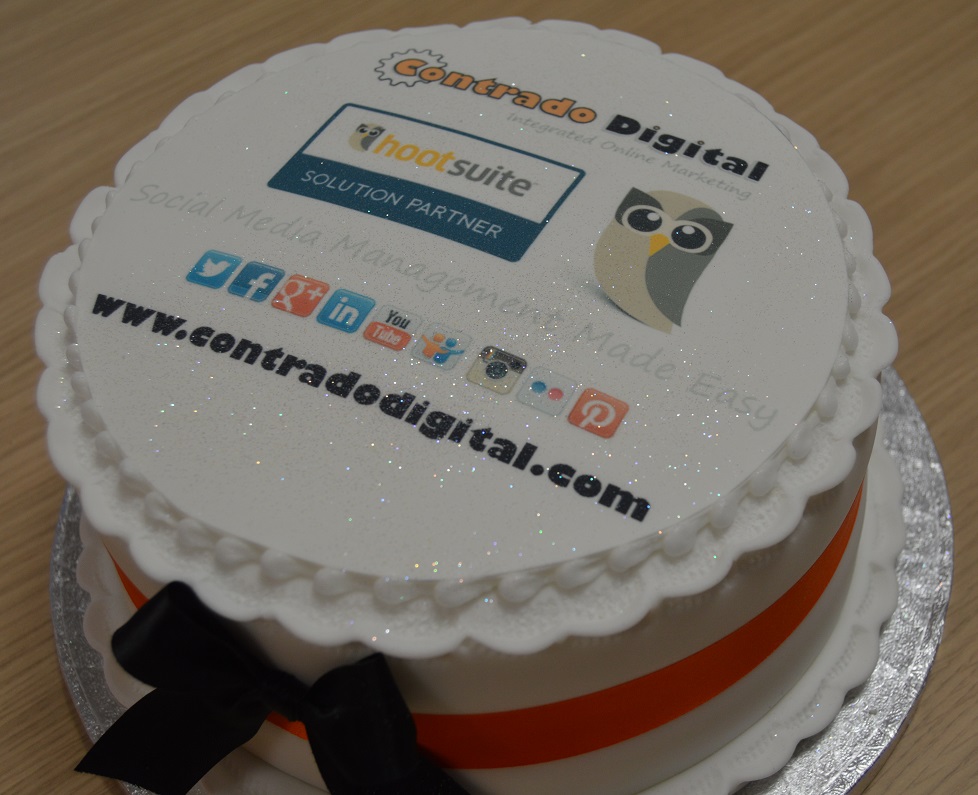
Contrado Digital HootSuite Solutions Partner
Om nom nom!
by Michael Cropper | Jan 27, 2014 | Digital Marketing, Events |
We recently attended a digital marketing conference in Manchester called SAScon where we heard some exciting statistics from some leading UK brands including ASDA and MoneySupermarket.com. So we thought we would share some of the insights from the event so you can see how this can apply to your business.

Session 1 – The State of the Digital PR Nation
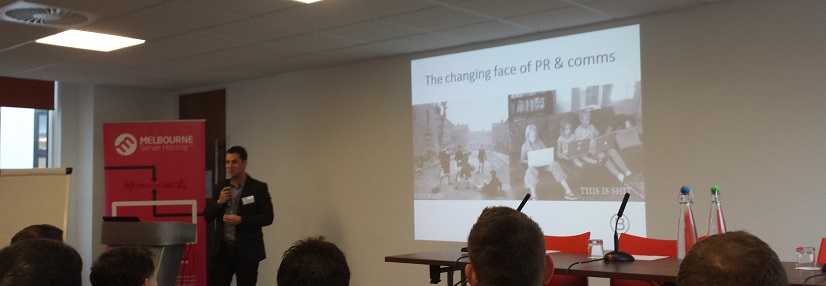
The first session of the day kicked off with a discussion around the state of the digital PR world with Drew Benvie, the Managing Director of a London based communications agency who talked through his experiences. The key message from the session was that social media has disrupted the PR industry with brands being able to connect with their audience easier and faster than ever before. So much so that the San Francisco Chronicle are putting all of their journalists through a two month social media boot camp.
Drew highlighted how businesses are increasingly moving away from the traditional social media manager and towards a more social business as we have illustrated below;
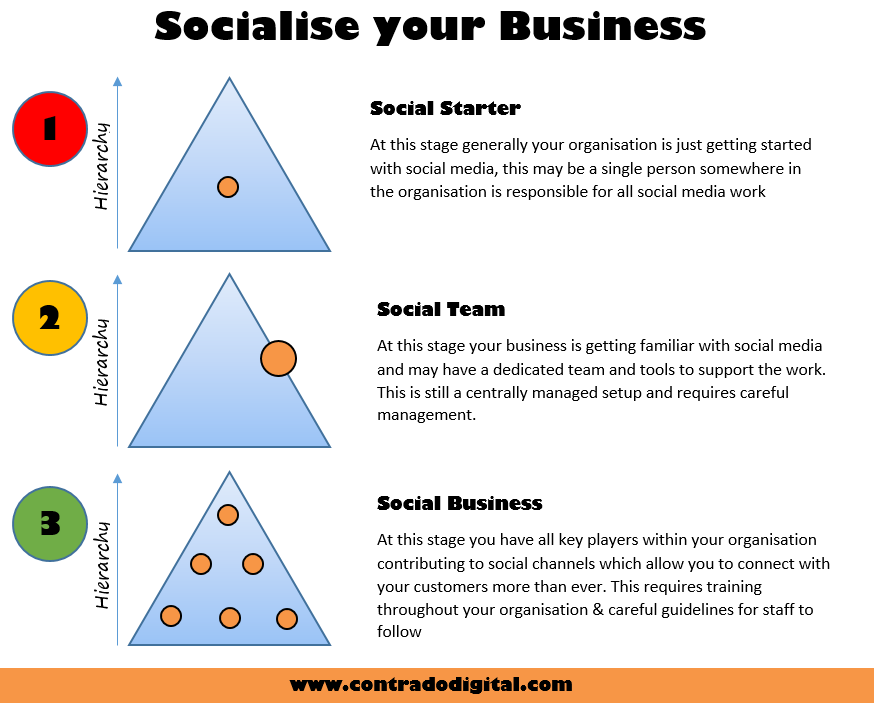
Socialise your Business
This involves everyone throughout an organisation to be utilising social media, from marketing teams, customer service teams, human resources teams, sales staff and C-level people. Businesses need to move from simply being digitally adapt, but also being socially adapt and with people checking their phones an average of 110 times per day this is a huge opportunity to get in front of your audience.
Turning traditional PR on its head was further highlighted with statistics that 90% of media is consumed on a screen of some sort which is a phenomenal amount.
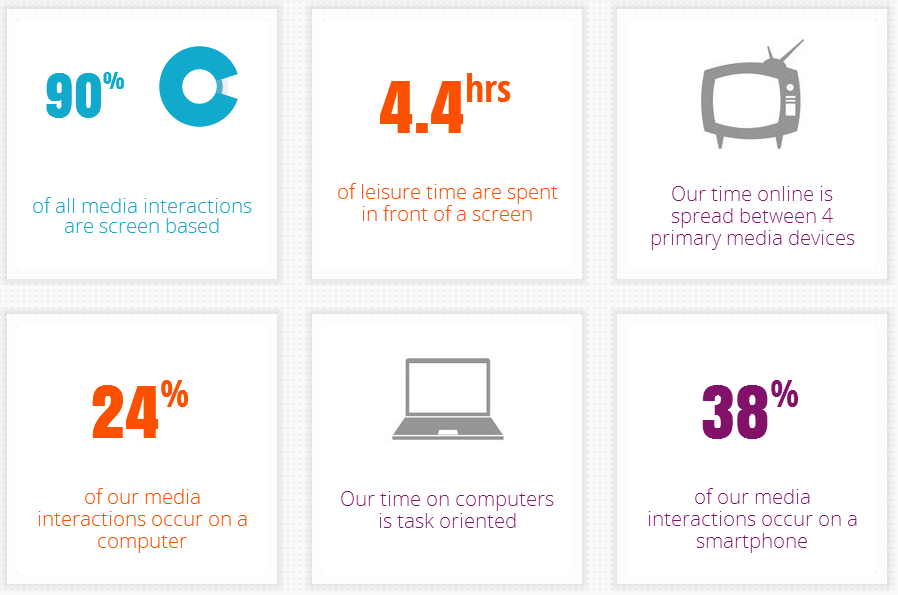
90% of all Media Interactions are Screen Based
The future was clearly looking towards a world of image sharing, wearable technology such as FitBit, messaging and data. With large brands looking beyond followers, fans, engagement & CTR and instead are using social media to drive footfall into their stores since the offline and online worlds are intrinsically linked. Brands are struggling to keep up with the warp speed changes within the industry though.
Session 2 – Where Next for Metrics
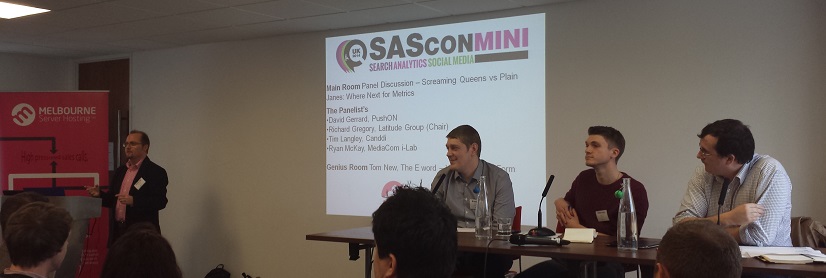
The next session was a panel to discuss where we are heading next for metrics and measuring success in the digital world. Some of the interesting points raised throughout the session was that while Universal Analytics has been available for a while now, it hasn’t really been picked up by many to utilise the full features available. It will be interesting as this gains more traction to see how brands begin to join data together in exciting ways. One example given was how one brand utilised custom dimensions within Universal Analytics to include weather conditions and geo-location to understand what impact website visitor numbers and revenue figures were impacted by these. One of the key features with Universal Analytics is the amazing ability to understand customers, not just visits. This is something to cover in a future post, but in summary Universal Analytics allows you to see when a customer visits from multiple devices which can provide some really cool data;

Universal Analytics
With data being so easy to capture, it is essential to capture as much data as possible to understand your customers better. Once the data has been captured, it can be analysed for a deeper understanding of trends and insights. On the topic of data, businesses are moving away from last click attribution models to track results, but looking at a more holistic approach and including data from first click attribution models. This helps to provide a true insight into how your business is performing which allows you to make smarter decisions about where to invest in the future.
Leading on from this additional data and understanding allows you to tailor content towards your audience. A prime example of this is for customers accessing your website from an iPhone while browsing for new laptops. It is extremely unlikely that those visitors are going to be interested in budget end PCs, instead show those customers products they are most likely interested in such as Apple laptops. Not only will this improve the customer experience, but this will also lead to an increase in conversions and sales.
On the content side, it was stressed about not simply creating content to generate links, but to fully understand where this content fits into the customer buying cycle. Only then will this content truly add value and deliver long term results. Content should be adding PR value, gaining mentions on other websites, being shared on social channels and the on-page data metrics should indicate how much customers enjoyed viewing the content.
With the recent change in (not provided), several companies in the digital space have attempted data modelling to retrieve this data by looking at Click Through Rate data on the search engine results pages along with keyword rankings. Although this hasn’t produced any models that are accurate enough to rely on. Following on from this, it was emphasised that a #1 ranking for a specific keyword isn’t the metric that businesses should be focusing on. In situations where a strong brand is ranking in position two or three, then this will still generate more clicks as customers prefer to view content from them than others. Metrics that businesses need to focus on in 2014 need to be focused around the right metrics for their business that are going to give a deep understanding of customers and not simply vanity metrics. Ultimately, revenue is the end point for most businesses to focus on, so other metrics need to work towards supporting this main KPI.
Session 3 – Why Content and Context are the Key to Making Meaningful Social Connections
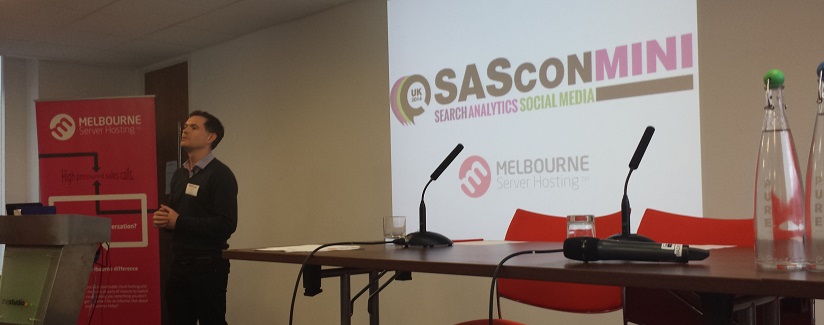
The third session of the day was from Dominic Burch, Head of Social at ASDA who gave a fast paced talk with insights into how ASDA utilise social media. Firstly what might surprise you is that an organisation the size of ASDA only has two people within their social media team, yet they manage hugely successful platforms that connect with their audience.
Dom started out with five simple thoughts;
1) The old rules don’t apply anymore
2) ASDA are a media owner and they’ll increasingly act like one
3) ASDA are a connector, not a collector
4) ASDA will only succeed if they win the trust of shoppers
5) Listen first, engage second, influence third
One clear theme throughout the day is that brands are increasingly stepping up to connect more with their audience and customers. To do this you need a good understanding of your customers, and it is clear that ASDA do know who their customers are. The image below clearly shows that ASDA know who their customers are and where they are online;
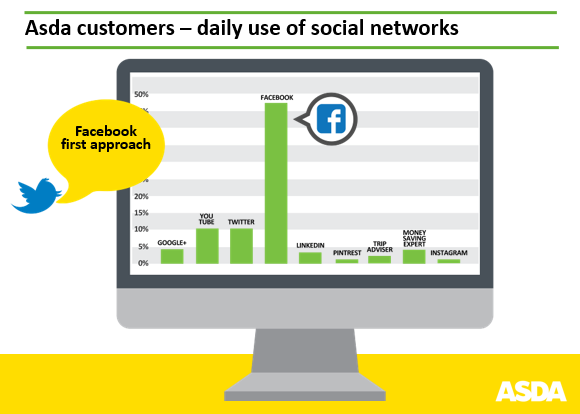
ASDA Customers on Social Media Channels
For ASDA, with Facebook being by far the most popular channel, this helps them to direct the strategy towards targeting those customers. Following on from this, ASDA also know that the typical Facebook follower has 232 friends and follow a total of 92 brands on Facebook, so ASDA need to keep their attention and stand out from the crowd.
One clear benefit of social media for ASDA is the ability to reach a huge audience and influence those people. On a monthly basis, ASDA’s Facebook page reaches 8.7 million people, generates 279,000 interactions and earns 157,000 clicks back through to their website. These are enormous numbers when remembering this is the work of only two people at ASDA. When comparing this to their traditional PR approach, where they were spending £150,000 per press release in a national newspaper (and they were running three of these per week!), it is clear that social media is a far greater opportunity to connect with their audience in a meaningful way. With the reach from social media, this tips the balance of power and enables ASDA to control their messages to their audience instead of going through traditional national newspapers.
While the above figures showcase the reach ASDA’s Facebook page has, Dom did stress that it is important not just to chase the numbers. Having a large following is utterly pointless if those people aren’t your target audience, a smaller number of more engaged followers are far more beneficial so connect to the right people with your messages.
In a similar theme, social media was compared with traditional TV advertising. ASDA has an 18% market share in the UK, meaning that running an advert on Coronation Street means that you are advertising to people who simply aren’t interested in the brand and wasting budget on this. Comparing this with social media, this allows a really targeted approach towards your audience to make your budget more effective at connecting with your audience.
Interestingly enough ASDA don’t have a huge budget for social media, so they have to focus on using relevant and low budget content that they can share socially. An example was given that with a £100 investment (yes, that low from a brand the size of ASDA!) resulted in content being shown in 100,000 newsfeeds of their audience. When comparing this to traditional PR, this is quite a difference. Another example of this was when a customer posted a question wondering if their dad was one of their oldest home shoppers. ASDA then went to visit the gentleman, took a photo and asked their Facebook fans to wish him a happy birthday which resulted in 25,000 likes for such a simply and cheap PR opportunity.
It was reiterated about the well-known fact that the best way to increase engagement on social media is to ask a question. This is clear when you compare ASDA’s engagement levels with their competitors;
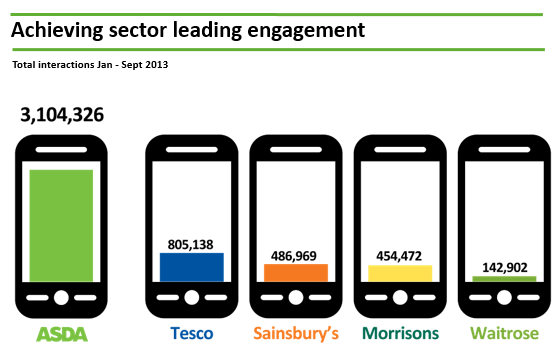
ASDA Social Media Engagement Levels
In-fact, ALDI do actually beat ASDA in terms of engagement levels, but this is a clear indication that ASDA are leading the way. One point made was that customers love it when ‘Del Boy Offers’ appear with the likes of 50p for 1 or 2 for £1. When customer see offers like this, straight away they are posted on social media channels which adds an extra dimension to the social media channels since it is essential these type of things don’t happen too often as it doesn’t show ASDA in a good light. Following on from this, in more extreme examples when there is a potential PR issue on social media, it is essential to take this offline to avoid it turning into a PR disaster. Never try and solve issues in a public space.
On the topic of follower growth, it was outlined that they have found promoting content and posts to friends of friends to be an effective method. The thought being that people who shop at ASDA are likely to be friends with other people who shop at ASDA. This can be seen in the graph below which contains the number of mentions over the past two years for ASDA;
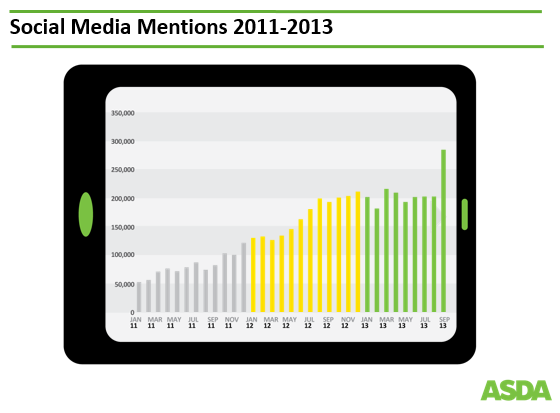
ASDA Social Media Mentions
Following on from this, ASDA had 268 million organic page impressions on their Facebook page. They were expecting to reach around the 300 million mark, although the Facebook update which tweaked their algorithm deciding what content to display in users newsfeeds really impacted ASDA’s organic visibility.
Taking a look in-store, some interesting statistics included that ASDA FM has a staggering 18 million listeners per week. Then looking at online and offline, the ASDA shop website gets 6 million visits per week, where 1 million of these use the store locator to find one of the 560 shops that are in the UK. Traditionally businesses have looked at online and offline as completely separate, although ASDA realise that people who shop online also shop in-store. So it is important to remember this when sending someone an email that they haven’t shopped online in a while, as they have likely been visiting in-store instead. They aren’t two completely separate groups of customers.
ASDA have started to link social media back to their website with their #ChosenByMe range which brings in social mentions together into a single place. A few other interesting ways ASDA is using social media can be seen on their editorial calendar below;
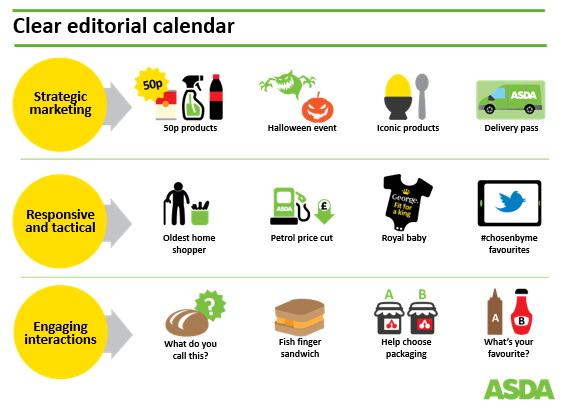
ASDA Social Media Editorial Calendar
From asking customers to help choose packaging on products, which resulted in 25,000 customers giving feedback within 1 hour, which is a huge opportunity for market research. To the good old debate about what sauce is best on a bacon butty, and ASDA found that it is quite evenly split. One key message was that content needs to start at the strategic level of your organisation. What key messages do you want to be talking about and who do you want to be talking to. Knowing this will help guide your social media activity.
Some final thoughts came around how we are going to be seeing much more of a ‘pay to play’ model on social media with changes in their algorithms leading to decreased visibility for brands. Long term we are going to see the death of the social media manager as we move towards social organisations at every level. Customers expect instant responses on social media channels and we are starting to see a much stronger interplay between social media and TV which was a similar theme mentioned at a recent event we attended, #SocialMediaWhatsTrending
Session 4 – Joining the Dots between PR, Social & Search
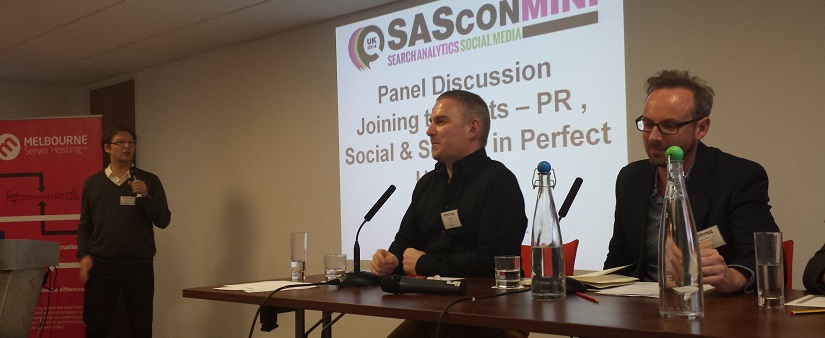
The next session was a panel discussion around the importance of joining the dots with digital marketing instead of treating each channel separately. The key message from the session was about how departments need to work together to achieve success. PR people need to be talking to SEO people, and vice versa. People working purely in SEO need to look towards telling stories to their audience. Then a common theme was around how everyone needs to be responsible for reputation management online. It is extremely easy for things to turn bad online, so everyone needs to be thinking about this with everything they are doing.
Session 5 – The top 5 Brands that ‘Get It and Deliver It’
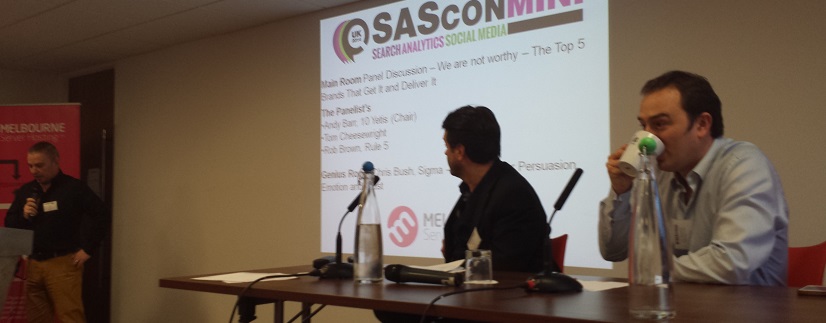
The fifth session of the day was another panel discussion that was focusing on brands that clearly understand the value of digital marketing.
Burberry
Interesting statistics including that 30% of all traffic to their website came from Facebook in 2013, with official sources stating that Facebook is a larger traffic source than Google for Burberry. This may not come as any surprise when you realise that 60% of Burberry’s marketing budget goes towards social media.
One of the most exciting thing about Burberry is how they have bridged the gap between digital and the real world within their Regent Street, London flagship store. If you haven’t seen this before, then just watch the video below and be mesmerised;
Red Bull
It is difficult to tell if Red Bull is a drinks company or a content marketing company now with what they produce. Just a few examples of how Red Bull have revolutionised content marketing by creating impactful and unusual content for their audience.
Then we have the Felix Baumgartner jumping from the stratosphere which was only available to watch on YouTube and the shortened version has had a staggering 35 million views;
British Cycling
Another example given was with British Cycling whereby at an event, they understood that social media was key to the event. So far as they had a social media hashtag on the cycling track and a van outside the venue with skills video editors in so they could take the footage, quickly edit and publish to social media channels. This resulted in content being available on YouTube after crashes within as little as 10 minutes from the event happening.
We are going to see much more of this event based marketing especially with the use of collaborative web tools which allow you to easily share content and data with your colleagues around the world within minutes.
Small Town Somewhere
A strange and slightly odd one was how one small town somewhere (Sorry, I can’t remember the name of it, but never the less, it highlights the point), actively used social media to publicise the town. What they did was to print & post a photo of everyone who liked their Facebook page onto a physical notice board within the town. Within a matter of hours, they had already filled up the board and continued to receive further mentions online.
NSA & GCHQ
The final one was rather tongue in cheek, with the NSA and GCHQ knowing everything about everyone. Who said government departments don’t ‘get’ social media.
Some other interesting points that came from the discussion was that everything works on an evidence based approach with digital unlike traditional marketing methods which can be notoriously difficult to measure accurately. It is important to use digital platforms to streamline communication and process, and if necessary completely remodel your business around what is possible. You have to ask yourself, is your organisation structured in a way that will help you succeed? You only have to look at the likes of HMV and Waterstones to see what can happen if you are too slow to adapt to changes in the market. This is specifically true of traditional media businesses, as they are needing to completely re-think their business to compete digitally.
One prime example given was how British Airways only monitor their social channels between 9-5 UK time, yet their customers are active around the clock as they travel to/from their destinations. This is a prime example of how businesses can adapt to the changing needs of customers to provide a superior service. Co-op have been an early adopter of Snapchat for marketing activities by running a campaign targeting students.
The key message throughout the session was that businesses need to get over the fear of failure, make changes fast and fail quickly. Some businesses are doing to need to fundamentally evolve throughout the organisation to keep ahead.
Session 6 – How to Break the Cycle of Bad Marketing
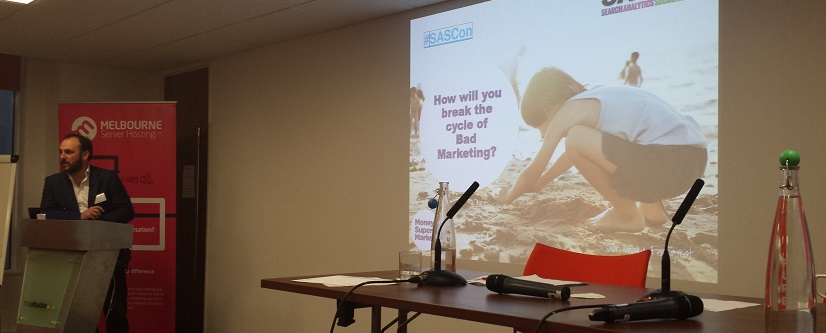
The final session of the day was from Phil MacKechnie, Head of Organic Performance at MoneySupremarket.com. Starting off with some exciting statistics, the three websites within the group TravelSupermarket.com, MoneySavingExpert.com and MoneySupermarket.com generate a huge 8 million visits per week.
Starting again with a key theme from throughout the day, the message was clear that businesses need to stop ignoring their customers and start to engage with them. Listen to them, help and support their needs with all marketing activities. There is no need to go chasing new big and shiny things, instead get back to the basics and start with your product, place, sales service and promotion. All of which need to be 100% focused on your customers.
Content is key for them as they communicate with their customers, so businesses need to get some good ideas and work together with key stake holders throughout the organisation. Working in silos has to stop and collaborative working is the only way to succeed long term. Purely from an efficiencies point, working together means more effective marketing spend and data can be shared between teams easily. Don’t get stuck in a content rut, understand what is working and what isn’t then adapt as necessary. This may result in having to look at team structures to understand how teams can work more effectively together.
A phenomenal 50% of all traffic is from mobile and tablet devices on TravelSupermarket.com, which really does highlight that a responsive website needs to be the number 1 priority in 2014. Customers are accessing your brand, content and website throughout the day on multiple devices, so your business needs to seriously consider what this means and what needs to be done to improve all these areas.
On the Search Engine Optimisation front, one only has to look at the messages Google is putting out about what not to do. These are clear indicators about what Google doesn’t like. Instead, start to look at campaigns and events as this will help with your Search Engine Optimisation efforts as well as building your brand. One message following on from this was that businesses that don’t have a strong brand online are going to find it ever more difficult to compete as customers look towards recognisable brands when purchasing online.
Finally the focus turned to KPIs within your business and the importance of getting these aligned. If different departments have competing KPIs then this simply isn’t going to work. Instead, work to align your business so all departments are working towards a clear strategy to target your customers.
Summary
Overall the SAScon event was extremely insightful as I’m sure you can see from the masses of information above. Hopefully this will give your business some food for thought about what you need to be working on in 2014 to succeed. Some of the key messages throughout is that you need to ensure your entire organisations is working towards a clear strategy to target your customers and forget about working in silos. There are some exciting examples above about how you can increase your organic reach across all channels.





































